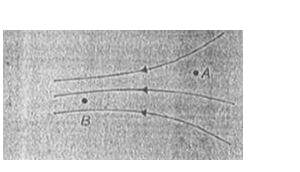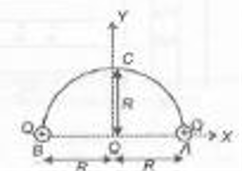12 j of work has to be done against an existion electric field to take a charge of 0.01 C from A to B. How much is th potential difference VB−VA?
To find the potential difference VB−VA when moving a charge in an electric field, we can use the relationship between work done, charge, and potential difference. The formula we will use is:
VB−VA=WQ
where:
- VB−VA is the potential difference between points B and A,
- W is the work done against the electric field,
- Q is the charge being moved.
1. Identify the given values:
- Work done W=12 joules
- Charge Q=0.01 coulombs
2. Substitute the values into the formula:
VB−VA=WQ=12 J0.01 C
3. Calculate the potential difference:
VB−VA=120.01=1200 volts
4. State the final answer:
The potential difference VB−VA is 1200 volts.
- VB−VA is the potential difference between points B and A,
- W is the work done against the electric field,
- Q is the charge being moved.
- Work done W=12 joules
- Charge Q=0.01 coulombs
VB−VA=WQ=12 J0.01 C
VB−VA=120.01=1200 volts
The potential difference VB−VA is 1200 volts.
Topper's Solved these Questions
- BOOK - HC VERMA ENGLISHCHAPTER - ELECTRIC FIELD AND POTENTIALEXERCISE - question for short answer14videos
ELECTRIC FIELD AND POTENTIAL
- BOOK - HC VERMA ENGLISHCHAPTER - ELECTRIC FIELD AND POTENTIALEXERCISE - Objective 19videos
ELECTRIC FIELD AND POTENTIAL
- BOOK - HC VERMA ENGLISHCHAPTER - ELECTRIC FIELD AND POTENTIALEXERCISE - worked out Examples19videos
ELECTRIC FIELD AND POTENTIAL
- BOOK - HC VERMA ENGLISHCHAPTER - ELECTRIC CURRENT THROUGH GASESEXERCISE - Short answer6videos
ELECTRIC CURRENT THROUGH GASES
- BOOK - HC VERMA ENGLISHCHAPTER - ELECTROMAGNETIC INDUCTIONEXERCISE - Questions for short answer9videos
ELECTROMAGNETIC INDUCTION
Similar Questions
Find Vba, if 12J of work has to be done against an electric field to take a charge of 10−2 C from a to b.
View SolutionHow much work is done in moving a charge of 2C across two points having a potential difference of 12V ?
View SolutionIf 20J of work has to be done to move an electric charge of 4C from a point, where potential is 10V to another point, where potential is V volt, find the value of V.
View SolutionThe work done in carrying a charge of 5μC form a point A to a point B in an electric field is 10mJ. The potential difference (VB−VA) is then
View SolutionIf 50 joule of work must be done to move an electric charge of 2 C from a point, where potential is V volt, the value of V is
View SolutionIn figure two points A and B are located in a region of electric field . The potential difference VB−VA is
 View Solution
View SolutionWhat is the amount of work done in moving a charge of 15 between two points kept at a potentia difference of 1.2 V?
View SolutionIn moving from A to B along an electric field line, the work done by the electric field on an electron is 6.4×10−19J. If ϕ1andϕ2 are equipotential surfaces, then the potential difference VC−VA is.
 .View Solution
.View SolutionA uniform electric field is present in the positive x - direction. If the intensity of the field is 5NC−1 then find the potential difference (VB−VA) between two points A (0 m, 2 m) and B (5 m, 3 m).
View SolutionTwo identical point charges are placed at A and B. The potential difference V0−VC is (k=14πε0)
 View Solution
View Solution

